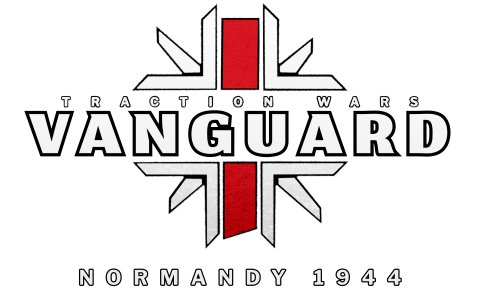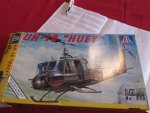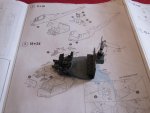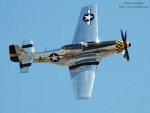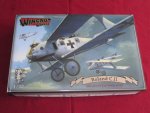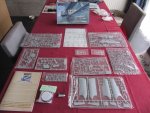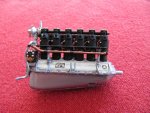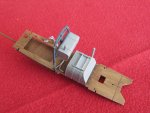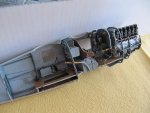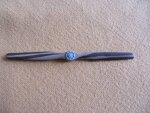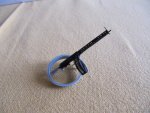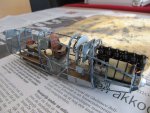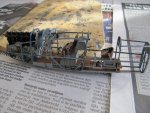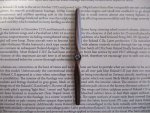th_battleaxe
Member
My fellow Tractionists
Given your positive reactions to my Heinkel 219, I thought you gentlemen would like an in-depth look into the art of model making. Over the coming posts, I will explain both basic and more advanced techniques to make a model look good, old, dirty, used, factory fresh and whatnot. This first post will be a bit long, so you might want to grab a coffee.
But first, the beginning.
Which is a good brand for model kits?
It depends. If you're a seasoned veteran, you could go for Dragon. They make excellent kits with huge amounts of detail. But they aren't the cheapest kits, and the level of detail means a lot of small parts, easily devoured by a shaggy rug. But they are very good kits, even the old ones. They usually come with a number of photo-etched parts, which require some skill to handle.
On the other side of the spectrum, we have Airfix! Yes, I know it's a bit of a cliché, but the new Airfix is shaping up to be a serious contender on the market again. Reviews of current Airfix kits are very promising. They offer a lot of detail, while keeping it simple. So, if you're new to the trade, go off to your local model store and buy an Airfix Hurricane.
In between these extremes, there are a lot of other brands who offer various qualities for various prices. Tamiya, Italeri, Trumpeter, Hasegawa, Hobby Boss, Meng, Revell, and the list goes ever on.
Revell is a bit of a tricky one. They generally have very good kits of their own, and of Monogram (they merged with this American company quite some time ago). However, be aware of 1/72nd scale tank and airplane kits. In a number of cases, these kits have been bought from older companies, such as Matchbox or Frog. The quality of these kits is often questionable.
I've got me kit, now what?
The basic supplies for a modeller include glue, paint, brushes, a file, sand paper, tweezers, a cutting board, a modelling knife, and some toothpicks. Some of these items you'll have lying about the house, others you'll have to go and buy.
Glue is best bought in a bottle with a brush or in a needle dispenser. The brush bottle is good for general work, the needle is handy in tight spaces, or with small parts. Paint is a different thing. You'd better hold off buying the paint until after you've opened the kit and had a look at the instructions. That way, you'll have a better understanding of your needs. Of course, over time you build up a collection of paint so this step will become obsolete.
I've found that currently it is best to use acrylic paint you can thin with water. They are user-friendly and they won't smell as bad as enamel paint. I would also recommend to do a bit of photographic research first to see what colours were actually used, because the instructions can vary from reality. Generally, each model requires black, white and aluminium paint, so its a good idea to keep those in permanent supply.
Coming up next: a practical example.
I hope you like it.
Given your positive reactions to my Heinkel 219, I thought you gentlemen would like an in-depth look into the art of model making. Over the coming posts, I will explain both basic and more advanced techniques to make a model look good, old, dirty, used, factory fresh and whatnot. This first post will be a bit long, so you might want to grab a coffee.
But first, the beginning.
Which is a good brand for model kits?
It depends. If you're a seasoned veteran, you could go for Dragon. They make excellent kits with huge amounts of detail. But they aren't the cheapest kits, and the level of detail means a lot of small parts, easily devoured by a shaggy rug. But they are very good kits, even the old ones. They usually come with a number of photo-etched parts, which require some skill to handle.
On the other side of the spectrum, we have Airfix! Yes, I know it's a bit of a cliché, but the new Airfix is shaping up to be a serious contender on the market again. Reviews of current Airfix kits are very promising. They offer a lot of detail, while keeping it simple. So, if you're new to the trade, go off to your local model store and buy an Airfix Hurricane.
In between these extremes, there are a lot of other brands who offer various qualities for various prices. Tamiya, Italeri, Trumpeter, Hasegawa, Hobby Boss, Meng, Revell, and the list goes ever on.
Revell is a bit of a tricky one. They generally have very good kits of their own, and of Monogram (they merged with this American company quite some time ago). However, be aware of 1/72nd scale tank and airplane kits. In a number of cases, these kits have been bought from older companies, such as Matchbox or Frog. The quality of these kits is often questionable.
I've got me kit, now what?
The basic supplies for a modeller include glue, paint, brushes, a file, sand paper, tweezers, a cutting board, a modelling knife, and some toothpicks. Some of these items you'll have lying about the house, others you'll have to go and buy.
Glue is best bought in a bottle with a brush or in a needle dispenser. The brush bottle is good for general work, the needle is handy in tight spaces, or with small parts. Paint is a different thing. You'd better hold off buying the paint until after you've opened the kit and had a look at the instructions. That way, you'll have a better understanding of your needs. Of course, over time you build up a collection of paint so this step will become obsolete.
I've found that currently it is best to use acrylic paint you can thin with water. They are user-friendly and they won't smell as bad as enamel paint. I would also recommend to do a bit of photographic research first to see what colours were actually used, because the instructions can vary from reality. Generally, each model requires black, white and aluminium paint, so its a good idea to keep those in permanent supply.
Coming up next: a practical example.
I hope you like it.
